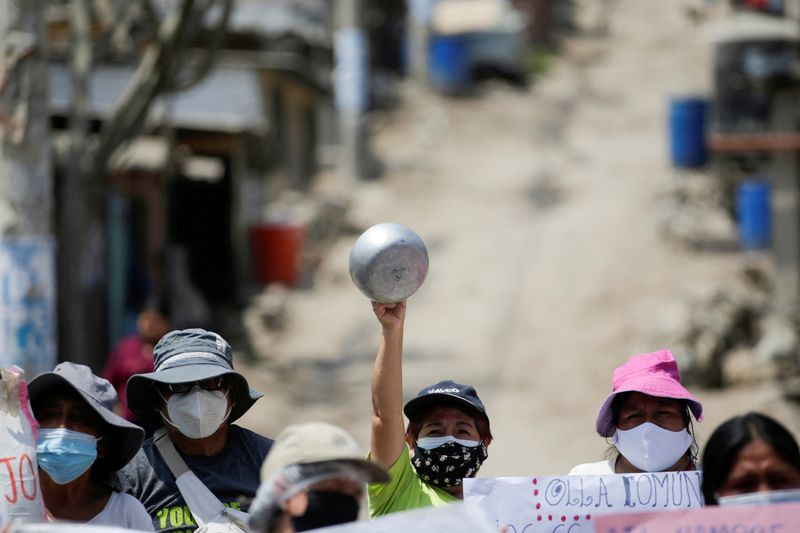By Marcelo Rochabrun
LIMA (Reuters) - Since 2011, Peruvians have lived under seven presidents and seen four ex-leaders detained or wanted on corruption allegations. Yet, in the same period Peru has held onto the unlikely title of the fastest growing major economy in Latin America.
That period of standout growth is set to end this year, an analysis of World Bank data and International Monetary Fund forecasts shows, with Colombia overtaking Peru.
Slowing growth at the world's No. 2 copper producer underscores a painful truth: Peru's economy is finally beginning to crack after years of increasingly disruptive political crises that have peaked under President Pedro Castillo and a combative Congress, hurting both private and public investment.
Global economic pressures like inflation prompted by the pandemic have hit Latin America hard, but the mood has turned particularly sour in Peru. Investor confidence is lower than during the Great Recession and nearing the pandemic's record low, even though business performance continues to improve, monthly polls from Peru's central bank analyzed by Reuters show.
"I think that there is no other option but that the government is affecting (economic) expectations because companies are doing fine," said Pedro Francke, Castillo’s inaugural finance minister who resigned earlier this year.
Castillo took office last July, spooking investors on the campaign trail with a plan to radically redistribute wealth and redraft the constitution. But he ultimately handed the economy to moderate finance czars and has passed no meaningful economic reforms.
Graphic: Peru has led GDP growth in Latam. That is set to end https://graphics.reuters.com/PERU-ECONOMY/zdvxozjympx/chart.png
His administration and close associates are now besieged by scandals. Castillo himself is facing six criminal investigations, one of them for alleged obstruction of justice in the firing of a minister. Congress has twice impeached him but failed to oust him.
While Peru is used to turmoil and in 2020 cycled through three presidents in nine days, market analysts say its economy is finally facing what may prove an insurmountable test.
"Politics and the economy can no longer be treated separately in Peru," Fitch said in a report this week.
Peru's finance ministry declined to comment.
To be sure, Peru is expected to remain among Latin America's top performing economies, according to the International Monetary Fund. Meanwhile, Moody's (NYSE:MCO), Fitch and S&P all told Reuters they do not see imminent risks of a downgrade to Peru's investment-grade rating.
Peru's largest corporations, including lender Credicorp (NYSE:BAP) and miner Sociedad Minera Cerro Verde, have presented solid earnings so far this year.
Still, Peru's finance ministry is set to lower its growth expectations for 2022 later this month from 3.6%, according to newly appointed Finance Minister Kurt Burneo who first suggested it could be as low as 2.2% but has since said it might be a bit higher.
"Today Peru is facing one more stress test...but what we won't be able to save is economic growth," said David Tuesta, the President of the Private Competitiveness Council, a think tank funded by business interests.
Graphic: Peruvian business confidence is nearing a record low https://graphics.reuters.com/PERU-ECONOMY/dwpkrwqgqvm/chart.png
A POPULIST WHO CAN'T SPEND
Castillo came to power promising to hike spending, fund new social programs and raise taxes on the mining industry.
But his administration has actually overseen slower public spending despite record tax revenues, while Congress shelved the mining tax reform.
Peru's fiscal deficit now sits at a very conservative 1% of GDP, a dramatic reduction from 8.9% just two years ago, all accomplished without an austerity policy in place.
"The bad news is that the deficit reduction is...because of the inability of this government to spend even on things that it wants to spend on," said Jaime Reusche, a vice president at Moody's.
Peru's central government spending has contracted 5% so far this year compared to last year, when Castillo was not yet in power, amid record turnover in senior government roles.
Graphic: Peruvian families are notably pessimistic about the economy https://graphics.reuters.com/PERU-ECONOMY/mopangbzova/chart.png
Less than two weeks into the job, Finance Minister Burneo said in an op-ed that Peru is risking a recession if it does not increase spending and criticized the central bank for hiking rates to combat inflation.
While many analysts have predicted that Castillo may not finish his term in 2026, opposition lawmakers have said that they lack the votes to oust him.

But even if they did, Castillo's removal may not shake up the economy, or change its trajectory toward slower growth.
"It shouldn’t have a major impact on economic activity and on real growth," Reusche said.